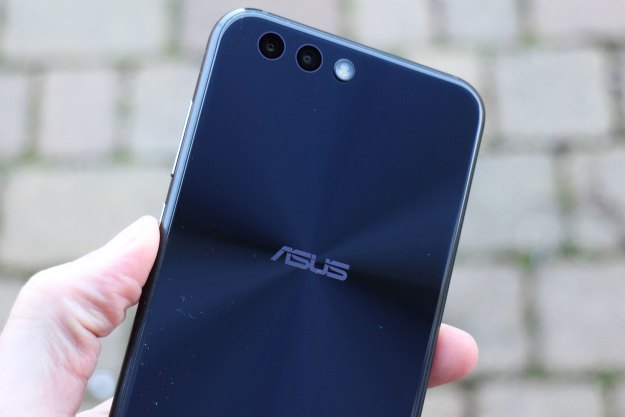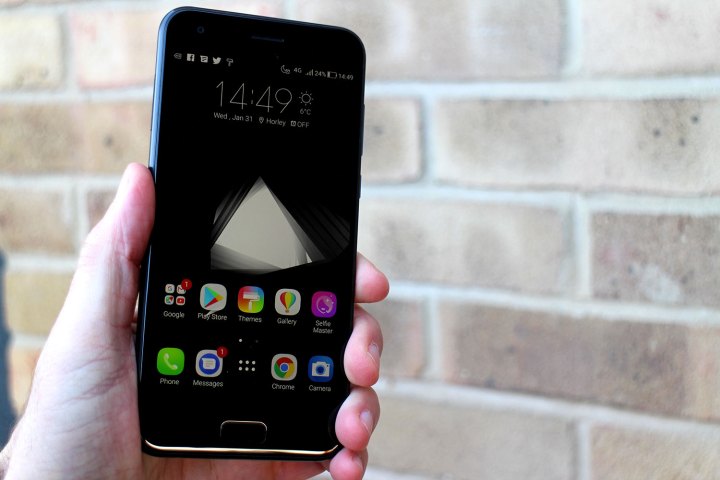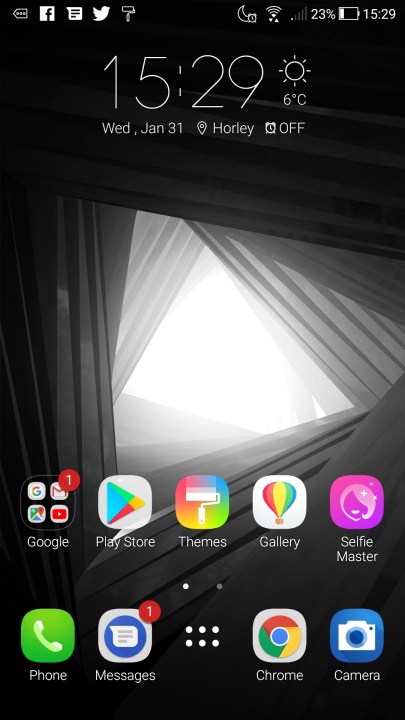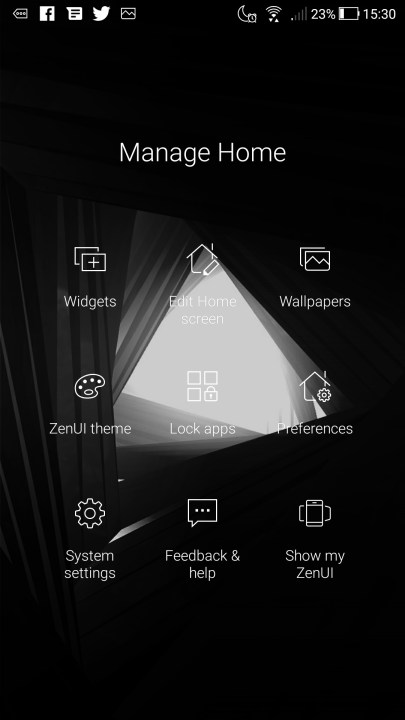
“Good audio performance can’t rescue the ZenFone 4 from its frustrating software.”
- Audio performance is excellent
- Reasonably priced
- Frustrating software
- Performance can be sluggish
- Disappointing camera
Asus may not be the best-known name in smartphones, but it has an extensive range of devices available in the U.S. and the U.K., at fairly reasonable prices. The brand name has a good following, largely due to its computers, but Asus has a quirky history with mobile products — releasing niche devices that often seem more experimental than anything else. Last year it unveiled the ZenFone AR smartphone utilizing Google’s soon-to-be-dead Tango augmented reality program; and even older devices like the Asus PadFone toyed with the idea of a smartphone combined with a tablet. As rumors about the ZenFone 5 heat up, we’re looking at the ZenFone 4, a phone that couples an unusual wide-angle camera with a slick design, and an affordable $400 price tag.
Starburst design
The ZenFone 4 packs relatively ordinary looks, but there’s one neat trick on the back. The Gorilla Glass 5 rear panel reflects light in a very precise way, causing a starburst-like pattern to erupt from the Asus logo. It’s no accident — it’s the same look seen on Asus laptops — and it looks really cool. Aside from the Asus logo and some small print at the bottom, the rear of the ZenFone 4 is uncluttered. Even the dual camera lenses are flush with the case. This is a by-product of the phone being thicker than many current big-name phones at 7.70mm.
The phone is very flat. There are no curves, outside of the rounded edges. It’s surprisingly not that slippery, but a transparent case inside the box is a welcome addition, offering peace of mind against drops that could crack the glass on the front or back. Putting it in the case does dull the starburst look a little, but it’s still visible with fewer fingerprints too.
It’s not ugly, but it’s not breaking any boundaries either.
An aluminum frame sits sandwiched between the two Gorilla Glass 5 panels, and there are two buttons on the right-hand side: A sleep/wake key, and a volume rocker. On the bottom is a 3.5mm headphone jack as well as a single speaker, alongside the USB Type-C charging port.
No-one is going to stop you in the street and ask what phone you’re holding. The ZenFone 4 is not ugly at all, but it’s not breaking any boundaries either.
Chunky bezels
The ZenFone 4 has bezels, or thick edges surrounding the screen. Compared to phones like the OnePlus 5T, the iPhone X, and the Samsung Galaxy S8, these bezels are enormous and make the phone look dated. It’s purely an aesthetic complaint — if anything, the fingerprint sensor below the screen is easier-to-grasp than the one on the Honor View 10, which squeezes its sensor into a slimmer bezel. The screen measures 5.5-inches, and it has a 1,920 x 1,080-pixel resolution.

The screen doesn’t get very bright, despite Asus’ claim of 600 nits of brightness. Still, we didn’t struggle to see it in every day lighting situations. We did note the screen changes the way pictures look through the camera viewfinder. What we saw on the screen looks much worse than the final image, which may be software-related, rather than screen-related.
Average camera
There are two lenses on the back of the ZenFone 4, but Asus has opted to replicate what LG does with its dual cameras on the LG G6 and LG V30, with a 12-megapixel lens with an f/1.8 aperture alongside a secondary 120-degree wide-angle, 8-megapixel lens. There’s 4-axis optical image stabilization (OIS), a 1.4 micron pixel size, dual-pixel PDAF, 4K video recording, RAW file support, and a pro manual mode. That’s a monster spec list, but how does the camera fare?
It performs well in the right situations. While the specs suggest great hardware, there are some compromises. For example, OIS is only present on the main camera, not the wide-angle lens, which has a lower aperture and doesn’t perform as well in low light. The main camera also doesn’t capture the good pictures in challenging light either, leaving us feeling a little let down.
On more than one occasion the ZenFone 4’s camera surprised us
But the camera does occasionally surprise us. Walking around town and shooting a few test pictures resulted in a great shot over rooftops into a gradually setting sun. The HDR mode balanced shadows and light effectively, and the picture was considerably evocative. That said, the wide-angle shots we took struggled with overcast skies, and didn’t pop as much as we hoped.
Asus includes a comprehensive editing suite in its Gallery app, which can be used to alter images to your preference; but the interface is confusing and not as intuitive as Snapseed or other third-party editing apps. This is a point we’ll return to later, as it’s indicative of the ZenFone 4’s main issue. It’s the same problem with the ZenFone 4’s selfie camera. There are many beautification effects for the 8-megapixel camera, but the controls don’t encourage you to explore, due to small icons and imprecise sliders for adjustments. The selfies enhanced by the beauty mode usually end up washed out and unpleasant.
There is a portrait mode that detects faces and blurs out the background. but we found this worked with the front camera, not the rear.
Asus also includes a separate selfie app which has a live video mode linked with Facebook, Instagram, YouTube, and Twitter. It merely jumps you into the app, rather than seamlessly starting a live-stream in the app.
There are much better camera phones out there at this price range. While we do like the wide-angle camera, we can’t quite stand the spotty performance and less-than-intuitive software.
Far from zen
The ZenFone 4 runs Android 7.1.1 with the September 2017 security patch, complete with Asus’ ZenUI over the top theme. While Huawei, LG, and Samsung are all moving towards a more stock Android appearance, Asus is not, and it’s all the worse for it. ZenUI is very different from Android on the Google Pixel 2, or almost any other Android phone we’ve used recently. Asus will say this makes it unique. We say it makes it annoying, and not very zen at all.
Examples? To dismiss notifications under the notification shade, the Clear button isn’t at the bottom of the list like one would logically assume, it’s right at the top of the screen and it’s easily missable. The included keyboard is one of Asus’ own construction, and its autocorrect feature has a frustrating tendency to pick the least likely word in the line-up. It’s slow to react, some buttons have terrible placement, and are often too small.
There is evidence of sluggishness throughout the standard software, from the camera app to the various pre-instated apps for selfies, call management, and a themes app. The software is not our favorite aspect of the ZenFone 4, although third-party apps — once open — zipped through the menus quickly. That suggests the phone itself doesn’t have performance issues, but ZenUI is just sluggish.
Solid performance
The phone is powered by Qualcomm’s Snapdragon 660 processor with 4GB of RAM, but there are some versions out there with a Snapdragon 630, depending on the region you purchase the device. We ran some benchmark tests to see how it performed:
- Geekbench 4: Multi Core: 4,128; Single Core: 870
- AnTuTu 3D: 69,052
- 3DMark Sling Shot Extreme: 835
These scores are very similar to the HTC U11 Life and the Moto X4, two phones that cost around the same as the ZenFone 4. We’ve mentioned the sluggish performance of ZenUI already, but this doesn’t extend to gaming, or movie watching. Playing simple games like Happy Hop and more graphically-intensive games like Reckless Racing 3, was pleasant and problem-free on the ZenFone 4.
One distinct advantage of the large bezels is having somewhere to hold the phone when playing games. Asus has its own game-monitoring app, which can be used to directly stream to YouTube or Twitch, plus silence notifications when you’re playing. Streaming YouTube and Netflix at 1080p was also faultless, whether on Wi-Fi or cellular.
Good battery life, great audio
The Asus ZenFone 4 is an awesome music device. Seriously. Purists will welcome the 3.5mm headphone jack, but it’s the presence of DTS Headphone:X technology that really sets it apart, along with Hi-Res audio file playback. We paired it with Tidal, and a pair of ordinary but decent AKG Y50 headphones. Asus’ own Audio Wizard app and the DTS Headphone:X personalization transformed the sound we heard.
The Asus ZenFone 4 is an awesome music device.
The app has a selection of profiles designed to match the headphones, and a series of soundstage and presets for different listening environments. The AKG Y50s were on the list, and the DTS profile pushed the bass to the max; when combined with the Wide soundstage setting, it sounded fantastic. When we didn’t want such pounding bass, it was simple to play with the settings and tailor it to the track. There are stereo speakers too, but no AptX HD for wireless playback.
Battery life has been good, with nearly two days average use from the 3,300mAh cell. The included fast charger took the battery from 10 percent to full in less than 90 minutes. Asus says a 36 minute charge will provide 50 percent capacity, which should see the phone last a day.
Price, availability, and warranty
In the U.S., Asus sells the ZenFone 4 through its own online store for $400, or $380 in a promotion running at the time of writing. In the U.K. it’s 450 British pounds through Amazon, or retailers including Carphone Warehouse. Asus puts a one-year warranty on its phones.
A word of warning for buyers in the U.S. There are international versions of the ZenFone 4 available through Amazon, and these may not have the required cellular bands to connect to 4G LTE networks. Make sure the device you’re purchasing is a U.S. device before paying out.
Our Take
Frustrating software made us lose our calm with the ZenFone 4, which is a shame when other aspects like the battery and audio performance are great for a phone at this price.
Are there any better alternatives?
Yes, there are. It’s a competitive field for Asus, with strong showings from HTC with the HTC U11 Life for $350, the $280 LG Q6, the $350 Moto X4, and the $200 Honor 7X for even less. The wide-angle camera definitely separates it from others though, and the audio is better than most phones. Spend a little more and it’s possible to get a considerably better phone. Most notably, the OnePlus 5T has a faster processor, more RAM, a better design, and a good camera for just $100 more.
In the U.K., the ZenFone 4 is expensive. It’s overshadowed by the Honor 9, the Honor View 10, and the OnePlus 5T, which are all available at around the same price, or even less. Crucially, the software experience on all these phones is superior to Asus’s ZenUI.
How long will it last?
The ZenFone 4 has a glass body and isn’t water resistant, so you’ll have to put it in a case and be wary of water, if you’re the clumsy type. The aging design looks old in early 2018, and will look even older in several months.
It runs an old version of Android now, and doesn’t have the latest security patch installed; but Asus promises an Android Oreo update is on its way to the phone right now. That’s good news, and ahead of some much larger phone manufacturers. Still, we have yet to see an update on our unit at the beginning of February 2018.
Should you buy it?
No. There are better phones available for the price, without the software pain points we experienced on the ZenFone 4. It’s a shame, because there are elements of the phone we like.
Editors' Recommendations
- The new Insta360 X4 looks like the ultimate action camera
- Wear OS 4 is coming to your smartwatch this year — here’s what’s new
- The best Samsung Galaxy Watch 4 Classic screen protectors
- The best Samsung Galaxy Z Flip 4 cases and covers for 2022
- Asus will show the small, powerful phone you’ve been waiting for on July 28





















